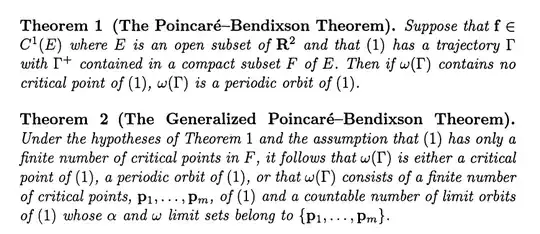You may start out with this vector-field:
$$ v = \pmatrix{ -y\\x}+(1-r^2)\pmatrix{x\\y}.$$
It has one critical point at the origin. Any other initial point will have the unit circle as its $\omega$-limit (so a typical periodic case in the P-B theorem).
Now multiply this vector field with $(1-r^2)^2$. Then the unit circle becomes a continuum of critical points since
the vector field vanishes there. On the other hand any non-critical point will still have the full unit-circle as $\omega$-limit.
The above is of course rather trivial as the factor $(1-r^2)^2$ simply slows the orbit down when approaching its $\omega$-limit. It may, however, be used in a more general construction that relies on some complex analysis: Take any Jordan curve $\gamma$ (topologically a circle) in the plane. I claim that you may realize that curve as an $\omega$-limit of a $C^1$ (or even $C^\infty$) vector field which has precisely $\gamma$ and one more point as critical sets.
To simplify the topology complete the plane with a point at infinity so it becomes the Riemann sphere.
The curve $\gamma$ separates the sphere into two simply-connected components $D_1$ and $D_2$ (suppose $D_2$ contains infinity).
The Riemann mapping theorem tells you that there is a conformal map $\phi_1$ taking the unit disc ${\Bbb D}$ conformally onto $D_1$ and similarly a map $\phi_2$ from the exterior of $\overline{\Bbb D}$ to $D_2$ (taking infinity to infinity). Now transport the vector field defined above from the unit disk to $D_1$ by $\phi_1$ and to $D_2$ by $\phi_2$. The derivative of the Riemann mappings typically blows up when approaching the boundary so a priori the vector-field will be singular on $\gamma$. However, by multiplying with a suitable scalar function going to zero fast enough (some subtle variation of the type $\exp(-1/(1-r^2)^2)$ you may kill the blow-up and assure that the resulting vector field becomes even $C^\infty$ and has precisely $\gamma$ plus one more point (the image of zero by $\phi_1$) as critical points. There are more general constructions in which for example any connected Julia set of a polynomial may be realized as $\omega$-limit and critical set (plus possibly some discrete set of critical points).
